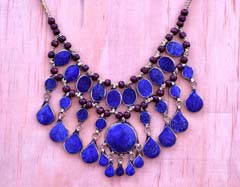#Jewellery made by #Afghanistan’s women

- Designing and selling handmade jewellery fashioned from tiny beads of the semi precious lapis lazuli stone has helped Khala Zada, a widow from Afghanistan, support her family of eight for the last 17 years.
In her fifties, Zada, who first learnt the art of bead making from a neighbour and now runs a small-scale business in downtown Kabul, is here to participate in a showcase featuring a collection of the intense blue semi precious stone jewellery
at the Amrapali store in the city.The showcased collection celebrates a partnership between Amrapali and Afghanistan’s Aayenda Jewellery Cooperative whose members comprise local Afghan craftswomen.
“I was engaged in carpet making from my childhood along with other household works. Now I dedicate 10 hours of the day
for bead-making and the remaining for my house. I am not the only one doing such things. Almost all the women in my village
are doing something or the other to support their families and contributing to the household income,” Zada said.Not fluent in either Hindi or English she spoke with the help of a translator.
In 2013, Zada along with 35 other artisans recieved training in jewellery design, craftsmanship, gem-cutting and business management skills at the Institute of Gems and Jewellery in Jaipur.
The 6-month long skill enhancement training programme, organised by a non governmental organisation Future Brilliance
also imparted training on the use of social media, m-commerce and basic IT skills to enable research, development and selling of products online with work placements at Amrapali.Zada says, it took her two months to convince her sons to allow her to travel to Jaipur but now she uses the skills learnt to train others back in her country Afghanistan, which is home to the world’s oldest lapis lazuli mines, some of which date back 7,000 years.
“She was different from other students, as after designing the jewelry she used to walk out of the institute and look for buyers for her work,” Sophie Swire, Executive Chairman, of Future Brilliance, who is part of a visting delegation from Kabul said.
Zada, who is unable to read and write, practices a 3000-year old tradition of handcarving micro sized lapis beads, using diamond tipped needles and pomegranate twigs. She sources ‘waste’ lapis stones from a local jeweller and uses that to fashion beads that are used in bracelets and other jewellery.

